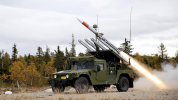Navy Budgets for 8 Ships, 107 Aircraft for Fiscal 2022 Procurement
28 May 2021 Richard R. Burgess
"ARLINGTON, Va. — The Navy Department’s fiscal 2022 budget requests totals $211.7 billion, a $3.8 billion increase over the enacted 2021 budget. The request includes funds for eight battle force ships and 107 aircraft. The Navy Department’s $211.7 billion request is part of the Defense Department’s $715 billion request....
...AIRCRAFT
Funding of aircraft procurement for 2022 totals $16.5 billion, a 15.6% decrease from 2021’s $19.5 billion. Navy aircraft requested for 2022 include 20 F-35C Lightning II strike fighters, five E-2D Advanced Hawkeye battle management aircraft, three CMV-22B Osprey carrier-onboard-delivery aircraft and 36 TH-73A training helicopters. For the Marine Corps, the request includes funds for 17 F-35Bs, six KC-130J Super Hercules tanker/transport aircraft, nine CH-53K King Stallion heavy-lift helicopters, five MV-22B Osprey assault transport tiltrotor aircraft and six MQ-9 extended-range Reaper medium-altitude surveillance unmanned aerial vehicles.
Notably, the budget contains no further funding for the F/A-18E/F Super Hornet strike fighter, P-8A Poseidon maritime patrol reconnaissance aircraft, the VH-92A presidential transport helicopter or the training version of the E-6B Mercury strategic communications aircraft. Procurement of these types has been completed, assuming no additions by the Congress. There is no 2022 request for funding for the MQ-4C Triton high-altitude, long-endurance UAV in that there is a pause in procurement while the UAV’s Integrated Functional Capability 4 is matured.
RDT&E funds are programed for the F-35, CH-53E, VH-92A, Next-Generation Jammer, F/A-18E/F Advanced Infrared Search and Track (IRST), and MQ-25 Stingray UAV.
The 2022 budget plan calls for accelerated divestment of legacy F/A-18A-D Hornet strike fighters, moving up the divestment of the 55 on strength from 2024 to 2022 and replacing them in the adversary role with F-16s transferred from the Air Force. Divestment of the RQ-4A Global Hawk Broad-Area Maritime Surveillance-Demonstrator UAV is planned for acceleration from 2023 to 2022, with the savings invested in higher priorities...."
https://seapowermagazine.org/navy-budge ... ocurement/

